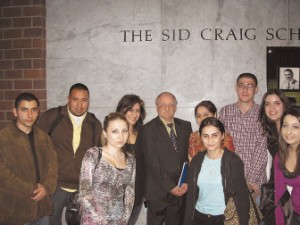By: Marisa Isquierdo

On Tuesday, March 24 at 7:30 PM, Dr. George Bournoutian gave the second of his three part lecture series on “The Armenian Church Under Foreign Rule: Persia, Russia, and South Asia 1600-1800,” to a full audience in the Alice Peters Auditorium at Fresno State. In this lecture, Dr. Bournoutian covered the topic “The Armenian Church under Russian Rule: 1600-1800.” He spoke on how the Armenian community in Russia had to fight for their right to practice their faith in their own church and the significant impact the Armenian Church had on Armenians in Russia. He cited numerous sources, such as letters and official documents, which he himself had translated from Russian into English.
Dr. Bournoutian is currently Kazan Visiting Professor of Armenian Studies for the Spring 2009 semester at Fresno State. He is senior Professor of East European and Middle Eastern Studies at Iona College in New York and the author of seventeen books.
Dr. Bournoutian gave a stirring presentation on the history of the Armenian Church under Russian rule during the period of the Romanov Dynasty from approximately 1600-1800. Audience members learned that the Armenians living in Russia at this time had to overcome Russian opposition to Armenians practicing their faith and to building Armenian churches. Dr. Bournoutian noted that Armenians had settled in Russia since the time of Ivan the Terrible in the tenth century, so by the seventeenth century, Russia had a substantial Armenian population, yet the Armenians were denied the opportunity to pray in Russian churches.
This changed in 1667 after Armenian merchants presented a diamond throne to the Russian Tsar, who then granted the Armenian community access to pray in Russian churches. Thirty years later, the Russian ruler Peter the Great permitted the Armenians to build a wooden church in Astrakhan. However, this church remained the only Armenian Church for the entire Armenian community in Russia until 1762.
Under the rule of Catherine the Great, 1762-1796, Armenians enjoyed a period of prosperity and Armenian churches were built in Moscow, St. Petersburg, and a second one in Astrakhan. Russia even forbade Catholic missionaries from converting Armenians.
Towards the end of his lecture, Dr. Bournoutian focused his attention on the Statutes (Polozheniye) of 1836. The Statutes defined the relationship between the Russian Government and the Armenian Church and are important because they remained in force until 1917. Dr. Bournoutian mentioned that historians view these Statutes as either having a positive or negative impact on the Armenian Church. He noted that some historians view these Statutes as either being “restrictions placed on the Armenian Church by Russia” or as “the official document that gave the Armenian Church its autonomy.”
Fresno State students showed their appreciation for Dr. Bournoutian’s lecture. “It is fascinating to learn about the Armenian culture and its impact in European society in its development,” commented Jonathan Munoz, a senior History major at Fresno State. Ani Simonyan, a junior History major at Fresno State, felt that “Dr. Bournoutian presented a history of 300 years in an informative way in our understanding of the Armenian Church under Russian rule.”
Dr. Bournoutian concluded his three part lecture series on Tuesday, April 21
 Hye Sharzhoom Armenian Action
Hye Sharzhoom Armenian Action